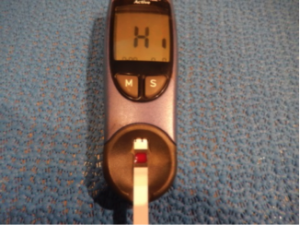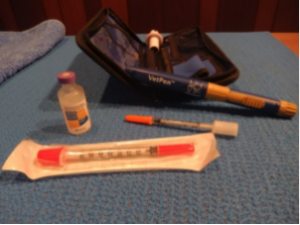

To raise awareness of the disease during the month of November, Cronulla Veterinary Clinic invites all our clients to submit a urine sample from their pet for free assessment. If you worry that the amount of water your pet is drinking and the excessive volume of urinating could be expressions of the common symptoms of Diabetes Mellitus, come by this month.
http://www.petdiabetesmonth.com/usefulterm.asp
What is Diabetes Mellitus?
Diabetes revolves around a small but very important organ: the pancreas, which is located near the stomach. The pancreas produces enzymes needed for proper food digestion, as well as hormones (such as insulin) that help regulate glucose (sugar) levels in the blood.
Sugar is needed by many cells for energy, and insulin acts like a key to let the glucose into the cells from the bloodstream.
The disease we call diabetes is the result of a shortage of insulin. There are two different types of diabetes. Type 1 diabetes occurs when the insulin producing part of the pancreas is damaged or otherwise dysfunctional. Type 2 diabetes occurs when the body has trouble using the insulin it makes. With type 2 diabetes, the pancreas tries to make more and more insulin to make up for the perceived lack. This eventually results in exhaustion and permanent damage to the pancreas and other systems in the body.
Without enough insulin, blood sugar (glucose) levels increase to abnormally high levels, and eventually excess glucose will leak into the urine. This will cause more water to be excreted, which makes the patient urinate more and therefore require more drinking water.
Without insulin, the body’s cells can’t utilize the available glucose, and they will need to burn other energy sources such as fat and protein. Unfortunately some parts of the body (specifically the brain and red blood cells) need glucose as their energy source. The excessive burning of other energy sources can lead to a build-up of toxins in the blood.
What symptoms do Diabetic animals show?
Uncomplicated diabetic animals show these classic symptoms:
-
Losing weight despite being hungry,
-
Drinking more and urinating more,
-
The animal is otherwise still bright and happy.
When Diabetes Mellitus continues too long without treatment, it develops into a more complicated form of diabetes, called “Diabetic Ketoacidosis”.
Animals with Diabetic Ketoacidosis are very unwell. These animals will still drink and urinate a lot but are also:
-
Depressed and lethargic
-
Can be vomiting and have diarrhoea
-
Are dehydrated
-
Sometimes a “sweet acetone breath” can be detected.
Diabetic Ketoacidosis is a medical emergency and requires immediate attention!
Diagnosis of Diabetes Mellitus
When Diabetes is suspected, a diagnosis is made based on urine and blood tests. Cats can be a little bit more complicated to diagnose, as sometimes stress can raise blood sugar levels. They may require additional testing.


Treatment of Diabetes Mellitus
Treatment of uncomplicated diabetic patients is usually straightforward. Generally, the owner will be required to give twice daily injections to their pet at 12 hour intervals. Discussion of diet and exercise regimes are important as well, especially for dogs. A fairly consistent routine will help the patient find a healthy balance to regulate their condition.
In the beginning, frequent blood testing is needed to determine the necessary and safe insulin dose for the individual patient. Once the disease is well regulated, testing can be done less frequently. Some patients can be more challenging in regulating, so understanding your pet’s symptoms and a building a close relationship with your vet is very important.
Cats especially can sometimes become less dependent on the insulin as their glucose levels normalize and some cats can even become non-diabetic again (although this may only be temporary).
Diabetic Ketoacidosis patients are very sick and usually need immediate hospitalisation. Treatment often includes IV fluids, frequent short-acting insulin injections, and very frequent blood sugar testing. This intensive care treatment can be time consuming and costly, and some cases can be very challenging. Once the animal is more stable and well, twice daily insulin treatments and lifestyle adjustments can be initiated, as for the “uncomplicated diabetic patient”.


Complications that can occur with diabetic patients include:
-
Development of cataracts (denser whiter lenses in the eyes, causing blindness). May sometimes be treated with eye specialist surgery. This happens most often to dogs.
-
Weakness and muscle wasting of the hind legs, caused by nerve damage from constantly high blood sugar levels. This happens mostly in cats.
-
Diabetics are more prone to infections, both urinary tract infections and other general infections.
-
The pancreas may have inflammatory flare ups from time to time. This can cause signs of “pancreatitis” (abdominal pain, nausea and vomiting, lack of appetite), as well as a disruption of the diabetes regulation.
-
Hypoglycaemia, which occurs when the blood sugar level gets too low and the brain especially is deprived of energy. This can be a life threatening emergency. Signs can vary from being tired and unresponsive, unusual behaviour, trembling/muscle twitching, weakness, anxiety, seizures, and at the most extreme coma and even death. As soon as hypoglycaemia is suspected, give your pet some honey or sugar water then take him straight to the vet for further treatment. THIS IS AN EMERGENCY SITUATION!
Overall, pets with Diabetes Mellitus can maintain a good quality of life, especially if diagnosed early and with appropriate treatment and monitoring. If you suspect that your pet may have diabetes, make the most of our free screening for the month of November.
